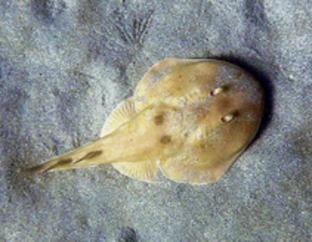Published in the Ocean Watch column, Honolulu Star-Advertiser © Susan Scott
December 5, 2011
It’s enough to worry about stepping on one of the bazillion stingrays that inhabit the bays here in the Sea of Cortez, but I need to worry about getting electrocuted, too?
That’s what I wondered after I took a picture of an unusual-looking ray and later discovered it’s called the giant electric ray. Was this a fanciful common name or are these fish really packing?
 Photo by Susan Scott
Photo by Susan Scott
The giant electric ray is also called the
Cortez electric ray or giant electric guitarfish.
They’re really packing. These rays can deliver a 14- to 37-volt shock, enough to knock a person down.
The giant electric ray is also called the Cortez electric ray, giant electric guitarfish, and by scientists, Narcine entemedor. This ray has about two dozen electric relatives in the world with the colorful common name of numbfish. Their electric organs consist of specialized cells that act as storage batteries wired in series.
Cortez electric rays live in shallow water on sand bottoms and are common from the Sea of Cortez (Gulf of California) to Panama. It’s a nocturnal species, growing to 30 inches long. During the day, this fish rests half buried in the sand, but at night it cruises the shallows in search of eels as well as worms, snails and other invertebrates. The Cortez electric ray uses its electric organs, one on each side of the eye, for defense only.
Another species, though, the Pacific electric ray, Torpedo californica, specializes in delivering its 45 or so volts to passing fish and swallowing them whole.
The Pacific electric ray is the only electric ray native to the West Coast of North America, ranging from Baja to British Columbia. (No electric rays are found in Hawaii.) During the day, the ray lies in the sand and ambushes passing fish. At night, though, this predator gets serious, rising from the bottom to hunt.
When an unlucky fish gets within a few inches of the ray, the ray lunges forward with tail thrusts to enfold the prey in its disc. The kick is so strong it sometimes sends the ray and its prey into barrel rolls or somersaults like a tumbling fish taco.
When the fish is secure, the ray shocks it, arranges the prey head-first toward its expandable mouth below and swallows it whole.
These fearless fish know they have a potent weapon. Although there are no reports of humans being shocked, Pacific electric rays have been known to charge divers that get in their way.
During all my dive and snorkeling excursions in Hawaii, I have seen only a handful of rays lying in the sand below me. Here in the Sea of Cortez, though, I’ve jumped into the water from my boat and sometimes it seemed as if the entire ocean floor rose up and shot away.
Rays are so numerous here my friends and I have stopped calling out, “Look, a ray!” But when I spotted that odd, giant guitar-shaped ray, it seemed well worth a stop for a picture.
Usually it’s hard to take an electrifying photo. This time it was easy.